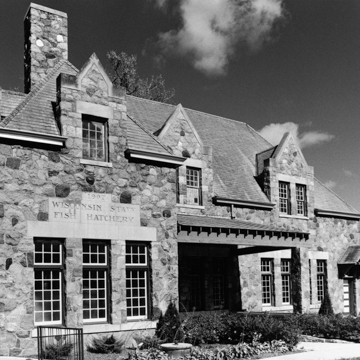This building in a park-like setting marks an early stage of Wisconsin’s place in the national fish hatchery movement, which emerged in the 1870s. Part of a wider conservation movement, hatcheries sought to ensure the availability of freshwater fish for market. Wisconsin launched its hatchery program in 1874, and this facility opened in 1907. Here, the Wisconsin Fisheries Commission staff propagated walleye fry in indoor jars and tanks and raised black bass in ponds outside. Once the fry reached sufficient length, they were released into Wisconsin rivers and lakes.
The hatchery evokes a Tudor Revival house, with shouldered gables trimmed in limestone. Colorful, random-coursed granite fieldstone walls add earthy rusticity, as does the irregular roofline studded with wall dormers and a prominent chimney. The rectangular core houses long concrete tanks where walleye were raised, and an office cube is set off the northwest corner. A drive curves through the broad lawns landscaped with trees. Six bass-raising ponds once dotted the forty-acre site, but only one remains. Fish-rearing operations ceased in 1950, but the facility continued as a research station until 1978. The building now houses a senior citizen center.


